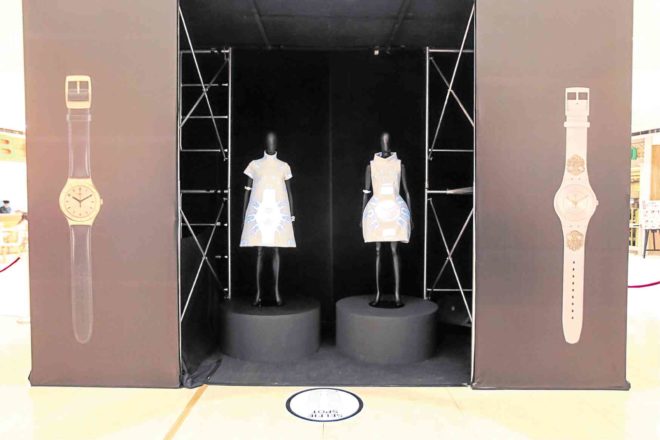
Sandy and Mark Higgins see it happen often enough: Student enrolls, works diligently, instructors spot the potential, then student drops out because student can no longer afford to finish the program.
The children of Salvacion Lim Higgins have now set up an educational fund, under their mother’s namesake, to provide financial help for promising students of the family-owned Slim’s Fashion and Arts School.
Their mother championed Filipino talent and believed that, given the right training, they could make an honest living through their skills. The fund was set up in her honor.
The school’s board, alumni and patrons have been supporting Slim’s scholars through the years, but Sandy and Mark Higgins, who run the school, haven’t formalized the scholarship program until now.
Slim—as the fashion designer was known in her illustrious career that spanned five decades until her passing in 1990—founded the school with her sister, Purificacion, in 1960. It has produced some of the most notable names in fashion—Joe Salazar, Cesar Gaupo, Michael Cinco, Albert Andrada, Ezra Santos, Joey Samson and James Reyes, among them.
The Higgins siblings initially aim to provide scholarships to existing students who exhibit talent but are financially challenged. The fund will also upgrade faculty skills and improve school facilities and teaching tools.
It should be noted how Slim’s occasionally brings in foreign experts, such as Savile Row master tailors from London, to mentor students.
Important theme
The Salvacion Lim Higgins Education Fund was launched at the annual Slim’s students’ exhibit, held Oct. 16-22 at SM Mega Fashion Hall, in partnership with SM and Swatch.
The exhibit, “Slim Inspires,” featured the exam projects of students, with an important theme: that the garments be based on the school founder’s body of work.
“Perhaps this year’s theme challenged the students a little more than usual because they’re aware of the standards my mother had, not to mention her work was anything but simple,” says Sandy Higgins.
“She believed in doing things the proper way, as opposed to using shortcuts, to achieve the right fit, the right fall of a garment, the right silhouette,” she adds.
“Clothes also had to be well-finished. What is taught in the school reflects her own approach and standards. It’s classic construction, the proper way.”
Slim, who belonged to the league of National Artist Ramon Valera, was known as a technician. She had a knack for unusual palettes, and her extraordinary silhouettes were the result of complex and architectural construction and technical study.
A simple-looking draped dress was often a work of precise and meticulous engineering. She had a penchant for “sculpting” fabric on the body, using fabrics of various weights.
Her so-called “Slim’s Method” is still the basis of instruction in the school.
Eye-catching pieces
Slim’s millennial students took on the daunting task with seeming gusto, with garments that surprised and even delighted the designer’s heirs.
“The exhibit pieces were studied, refined and very well-executed,” says Sandy. “Most of the students weren’t literal in their inspirations, but instead captured and built on the spirit of my mother’s work. Fresh thinking and a great deal of craft went into the clothes. I was pleasantly surprised by the depth and sophistication of some ideas, given most students are so young.”
She and her brother were quite taken by the students’ interpretations of the barong tagalog, like that of Genesis Alcantara, which sported ruffles and beadwork, and Hannah Adria’s, with overlapping layers and shoulder beadwork.
Slim never made menswear, but “applying her signature aesthetics to barong made for some pretty interesting pieces,” her daughter says.
Among the more eye-catching pieces was a burgundy terno with architectural tapis in chartreuse by Myka Dominado, a nod to Slim’s construction.
The same can be said of Niv Lagman de Leon’s black terno with a funnel-like accent on its fishtail skirt, and Leo Cadete’s little black dress with a pleated bustle-like detail at the back. The Slim influence in each of those works was evident, but they also looked current.
“Every time we set up exhibitions, I marvel at the diversity and creativity,” Sandy says. “It never gets tired. And I inevitably add dimension to my perception of the millennial mind. I think millennials are underestimated, even by themselves.”
Slim’s is noted for garment construction, indeed one of the school’s strengths.
Sandy adds, however, that “while construction seems to get all the attention, fashion design is an equally important course at Slim’s. Design and construction should be fused. One without the other would be like working with one hand. That view is probably what makes Slim’s different.
“Think of it this way: An architect who understands engineering is more likely to do
interesting, groundbreaking work. Both our design and construction courses are intense—the latter more so because of the sheer volume of techniques to be learned. We’re probably among the few schools left in the world that teach this level of classic construction. Once a student learns the long hand, he or she can devise their own short hand later.”
Inspires”